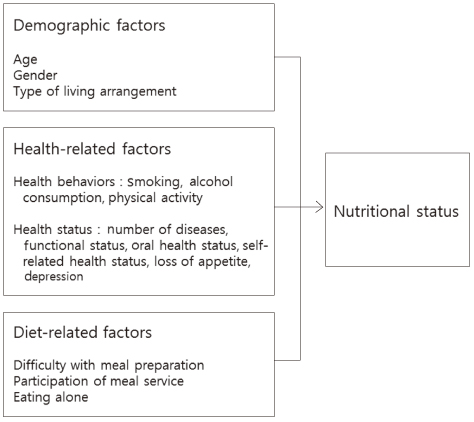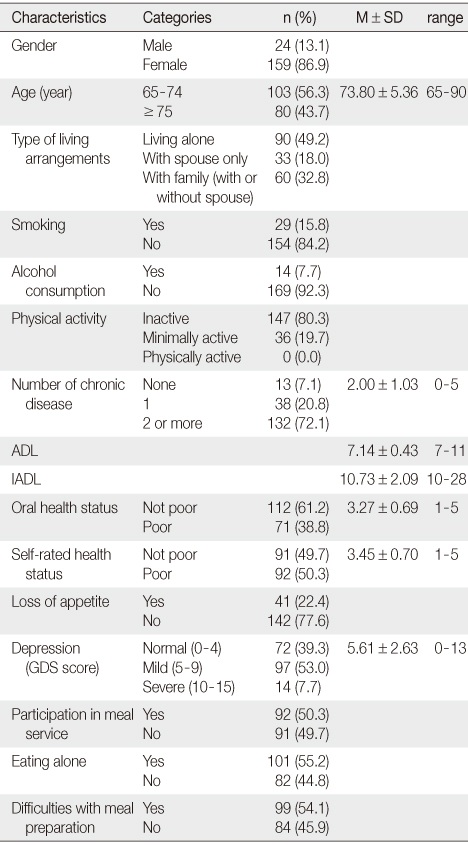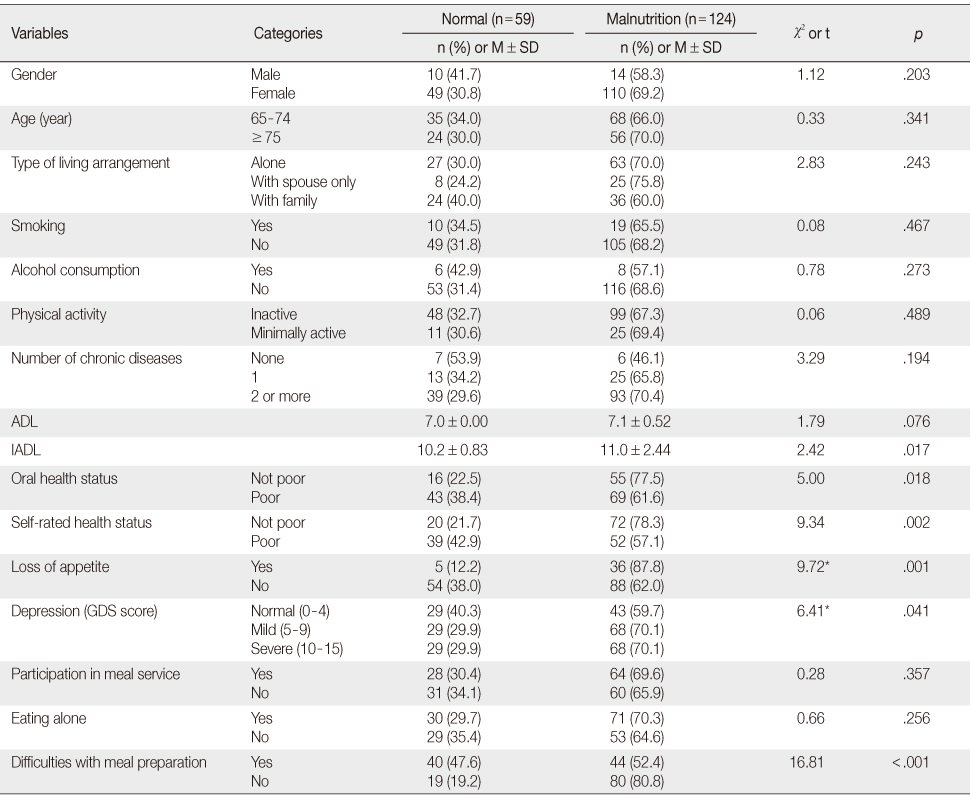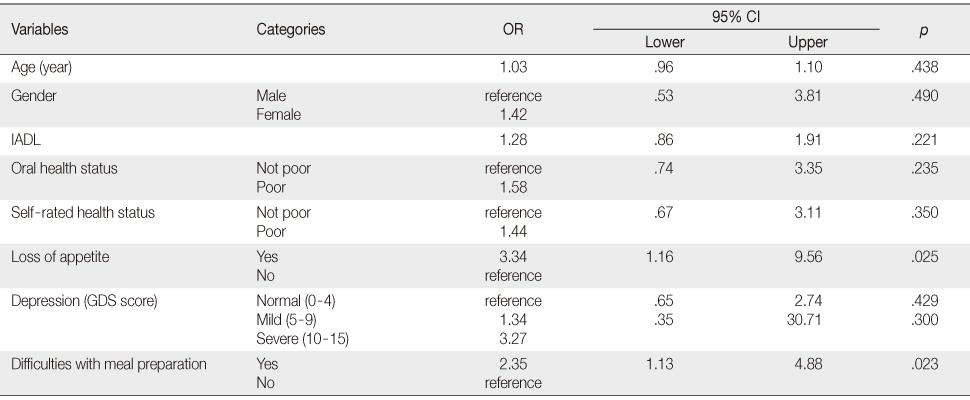Articles
- Page Path
- HOME > J Korean Acad Nurs > Volume 44(6); 2014 > Article
-
Original Article
- Nutritional Status and Risk Factors for Malnutrition in Low-income Urban Elders
- Hye Sun Hyun, Insook Lee
-
Journal of Korean Academy of Nursing 2014;44(6):708-716.
DOI: https://doi.org/10.4040/jkan.2014.44.6.708
Published online: December 31, 2014
1Department of Nursing, Sangmyung University, Cheonan, Korea.
2College of Nursing, Seoul National University, Seoul, Korea.
- Address reprint requests to: Lee, Insook. College of Nursing, Seoul National University, 103 Daehak-ro, Jongno-gu, Seoul 110-799, Korea. Tel: +82-2-740-8828, Fax: +82-2-765-4103, lisook@snu.ac.kr
© 2014 Korean Society of Nursing Science
This is an Open Access article distributed under the terms of the Creative Commons Attribution NoDerivs License. (http://creativecommons.org/licenses/by-nd/4.0/) If the original work is properly cited and retained without any modification or reproduction, it can be used and re-distributed in any format and medium.
Abstract
-
Purpose
- The purpose of this study was to evaluate the nutritional status of low-income urban elders by diversified ways, and to analyze the risk factors for malnutrition.
-
Methods
- The participants in this study were 183 low-income elders registered at a visiting healthcare facility in a public health center. Data were collected using anthropometric measurements, and a questionnaire survey. For data analysis, descriptive statistics, χ2-test, t-test, Fisher's exact test, multiple logistic regression analysis were performed using SPSS 20.0.
-
Results
- Regarding the nutritional status of low-income elders as measured by the Mini Nutritional Assessment (MNA), 10.4% of the elders were classified as malnourished; 57.4% as at high risk for malnutrition; and 32.2% as having normal nutrition levels. The main factors affecting malnutrition for low-income elders were loss of appetite (OR=3.34, 95% CI: 1.16~9.56) and difficulties in meal preparation (OR=2.35, 95% CI: 1.13~4.88).
-
Conclusion
- In order to effectively improve nutrition in low-income urban elders, it is necessary to develop individual intervention strategies to manage factors that increase the risk of malnutrition and to use systematic approach strategies in local communities in terms of a nutrition support system.
This manuscript is a condensed form of the first author's doctoral dissertation from Seoul National University.
- 1. Hickson M. Malnutrition and ageing. Postgrad Med J. 2006;82(963):2–8. http://dx.doi.org/10.1136/pgmj.2005.037564ArticlePubMedPMCPDF
- 2. Kaiser MJ, Bandinelli S, Lunenfeld B. The nutritional pattern of frailty-Proceedings from the 5th Italian Congress of Endocrinology of Aging, Parma, Italy, 27-28 March 2009. Postgrad Med J. 2009;12(4):87–94. http://dx.doi.org/10.3109/13685530903296706Article
- 3. Ödlund Olin A, Koochek A, Ljungqvist O, Cederholm T. Nutritional status, well-being and functional ability in frail elderly service flat residents. Eur J Clin Nutr. 2005;59(2):263–270. http://dx.doi.org/10.1038/sj.ejcn.1602067ArticlePubMedPDF
- 4. Ahmed T, Haboubi N. Assessment and management of nutrition in older people and its importance to health. Clin Interv Aging. 2010;5:207–216.PubMedPMC
- 5. Morley JE. Undernutrition in older adults. Fam Pract. 2012;29:Suppl 1. i89–i93. http://dx.doi.org/10.1093/fampra/cmr054ArticlePubMed
- 6. Chen CC, Schilling LS, Lyder CH. A concept analysis of malnutrition in the elderly. J Adv Nurs. 2001;36(1):131–142.ArticlePubMed
- 7. Kaiser MJ, Bauer JM, Ramsch C, Uter W, Guigoz Y, Cederholm T, et al. Frequency of malnutrition in older adults: A multinational perspective using the mini nutritional assessment. J Am Geriatr Soc. 2010;58(9):1734–1738. http://dx.doi.org/10.1111/j.1532-5415.2010.03016.xArticlePubMed
- 8. Iizaka S, Tadaka E, Sanada H. Comprehensive assessment of nutritional status and associated factors in the healthy, community-dwelling elderly. Geriatr Gerontol Int. 2008;8(1):24–31. http://dx.doi.org/10.1111/j.1447-0594.2008.00443.xArticlePubMed
- 9. Han Y, Li S, Zheng Y. Predictors of nutritional status among community-dwelling older adults in Wuhan, China. Public Health Nutr. 2009;12(8):1189–1196. http://dx.doi.org/10.1017/s1368980008003686ArticlePubMed
- 10. Johansson L, Sidenvall B, Malmberg B, Christensson L. Who will become malnourished? A prospective study of factors associated with malnutrition in older persons living at home. J Nutr Health Aging. 2009;13(10):855–861.ArticlePubMedPDF
- 11. Ministry of Health & Welfare, Korea Centers for Disease Control & Prevention. Korea health statistics 2011: Korea national health and nutrition examination survey (KNHANES V-2). Seoul: Ministry of Health & Welfare; 2012.
- 12. Kim SH, Kwon SC. Nutritional status among elderly Korean women and related factors. J Korean Biol Nurs Sci. 2012;14(1):16–24.Article
- 13. Han HJ, Kim NC. Mini nutritional assessment of elders in rural areas. J Korean Gerontol Nurs. 2007;9(1):22–28.
- 14. Yang SJ. Nutritional risk and its contributing factors in the low-income elderly in urban areas. J Korean Acad Community Health Nurs. 2005;16(4):392–403.
- 15. Kang Y, Kim M, Lee E. The relationship of perceived health status, activities of daily living and nutrition status in the community-dwelling Korean elderly. J Korean Acad Nurs. 2008;38(1):122–130. http://dx.doi.org/10.4040/jkan.2008.38.1.122Article
- 16. Posner BM, Jette AM, Smith KW, Miller DR. Nutrition and health risks in the elderly: The nutrition screening initiative. Am J Public Health. 1993;83(7):972–978.ArticlePubMedPMC
- 17. Chen LK, Lin MH, Hwang SJ, Wang P, Chwang LC. Nutritional status and clinical outcomes among institutionalized elderly Chinese in Taiwan. Arch Gerontol Geriatr. 2007;44(3):315–323. http://dx.doi.org/10.1016/j.archger.2006.07.002ArticlePubMed
- 18. Statistics Korea. Elderly statistics 2011. Daejeon: Author; 2012.
- 19. Yim KS, Lee TY. Sociodemographic factors associated with nutrients intake of elderly in Korea. Korean J Nutr. 2004;37(3):210–222.
- 20. Hsieh FY, Bloch DA, Larsen MD. A simple method of sample size calculation for linear and logistic regression. Stat Med. 1998;17(14):1623–1634.ArticlePubMed
- 21. Park S, Park YH. Predictors of physical activity in Korean older adults: Distinction between urban and rural areas. J Korean Acad Nurs. 2010;40(2):191–201. http://dx.doi.org/10.4040/jkan.2010.40.2.191ArticlePubMed
- 22. Ministry of Health & Welfare. 2012 family health program guidelines. Seoul: Author; 2011.
- 23. Landi F, Liperoti R, Russo A, Giovannini S, Tosato M, Barillaro C, et al. Association of anorexia with sarcopenia in a community-dwelling elderly population: Results from the ilSIRENTE study. Eur J Nutr. 2013;52(3):1261–1268. http://dx.doi.org/10.1007/s00394-012-0437-yArticlePubMedPDF
- 24. Guigoz Y, Vellas B, Garry PJ. Assessing the nutritional status of the elderly: The Mini Nutritional Assessment as part of the geriatric evaluation. Nutr Rev. 1996;54(1 Pt 2):S59–S65.Article
- 25. Lee GS. Nutritional evaluation by using mini nutritional assessment (MNA) and relating factors of postoperative recovery for elderly in gastric cancer [master's thesis]. Busan, Kosin University. 2004.
- 26. Phillips MB, Foley AL, Barnard R, Isenring EA, Miller MD. Nutritional screening in community-dwelling older adults: A systematic literature review. Asia Pac J Clin Nutr. 2010;19(3):440–449.PubMed
- 27. Kwon SC, Choe MA, Kim KS, Yi MS, Suh E, Suh M. Nutritional status, nutrients intakes, and health status of young-old and old-old homebound elderly in Korea. J Korean Biol Nurs Sci. 2012;14(3):183–192. http://dx.doi.org/10.7586/jkbns.2012.14.3.183Article
- 28. Landi F, Russo A, Liperoti R, Tosato M, Barillaro C, Pahor M, et al. Anorexia, physical function, and incident disability among the frail elderly population: Results from the ilSIRENTE study. J Am Med Dir Assoc. 2010;11(4):268–274. http://dx.doi.org/10.1016/j.jamda.2009.12.088ArticlePubMed
- 29. Donini LM, Dominguez LJ, Barbagallo M, Savina C, Castellaneta E, Cucinotta D, et al. Senile anorexia in different geriatric settings in Italy. J Nutr Health Aging. 2011;15(9):775–781.ArticlePubMedPDF
- 30. Lee SG, Jeon SY, Lee JY. Factors related with low body weight in older adults at a urban-rural composite area. J Korean Gerontol Soc. 2008;28(1):105–121.
- 31. Han SJ, Kim HK, Storfjell J, Kim MJ. Clinical outcomes and quality of life of home health care patients. Asian Nurs Res. 2013;7(2):53–60. http://dx.doi.org/10.1016/j.anr.2013.03.002Article
REFERENCES
Figure & Data
REFERENCES
Citations

- The longitudinal reciprocal relationship between food insecurity and depressive symptoms among Korean elderly who live in poverty: application of auto-regressive cross-lagged model
Jayoung Cho
Asia Pacific Journal of Social Work and Development.2023; 33(2): 86. CrossRef - Determinants of nutritional status among old age population in eastern Ethiopia: a general linear model approach
Liyu Derbie, Abdu Oumer, Ketema Ayele, Anteneh Berhane
Journal of Nutritional Science.2022;[Epub] CrossRef - Aging and nutrition. Paving the way to better health
Emilio Molina-Molina, Gabriella Garruti, Harshitha Shanmugam, Domenica Maria Di Palo, Ignazio Grattagliano, Tecla Mastronuzzi, Piero Portincasa
Romanian Journal of Internal Medicine.2020; 58(2): 55. CrossRef - Nutrition as a Health Determinant in Elderly Patients
Tecla Mastronuzzi, Ignazio Grattagliano
Current Medicinal Chemistry.2019; 26(19): 3652. CrossRef - Prevalence of malnutrition and associated factors among community-dwelling older persons in Sri Lanka: a cross-sectional study
H. D. W. T. Damayanthi, F. M. Moy, K. L. Abdullah, S. D. Dharmaratne
BMC Geriatrics.2018;[Epub] CrossRef - Identifying Latent Classes of Risk Factors for Coronary Artery Disease
Eunsil Ju, JiSun Choi
Journal of Korean Academy of Nursing.2017; 47(6): 817. CrossRef - Association of Family Composition and Metabolic Syndrome in Korean Adults Aged over 45 Years Old
Young-Ju Kim
Asian Nursing Research.2015; 9(4): 349. CrossRef - Factors Associated With Food Insecurity Among the Korean Elderly: Using Ordered Logistic Regression Analysis
조자영
Health and Social Welfare Review.2015; 35(4): 375. CrossRef

Figure 1
Demographic Characteristics of Participants (N=183)
ADL=Activities of daily living; IADL=Instrumental activities of daily living; GDS=Geriatric depression scale.
Nutritional Status of the Participants by MNA (N=183)
MNA=Mini nutritional assessment.
Differences of Nutritional Status according to Demographic, Health and Diet-related Characteristics of the Participants (N=183)
ADL=Activities of daily living; IADL=Instrumental activities of daily living; GDS=Geriatric depression scale; *Data obtained from Fisher's exact test.
Factors affecting Nutritional Status using Multiple Logistic Regression Analysis (N=183)
IADL=Instrumental activities of daily living; GDS=Geriatric depression scale; χ2=8.76, p=.363 by Hosmer and Lemeshow Goodness-of-Fit test.
ADL=Activities of daily living; IADL=Instrumental activities of daily living; GDS=Geriatric depression scale.
MNA=Mini nutritional assessment.
ADL=Activities of daily living; IADL=Instrumental activities of daily living; GDS=Geriatric depression scale; *Data obtained from Fisher's exact test.
IADL=Instrumental activities of daily living; GDS=Geriatric depression scale; χ2=8.76,
 KSNS
KSNS
 E-SUBMISSION
E-SUBMISSION





 Cite
Cite

